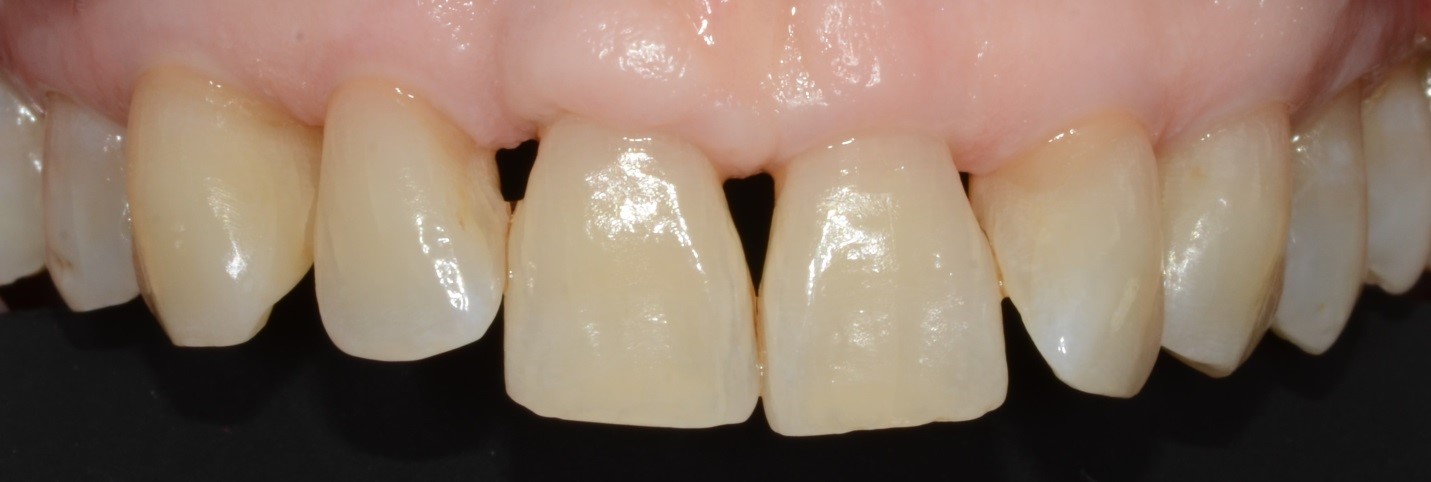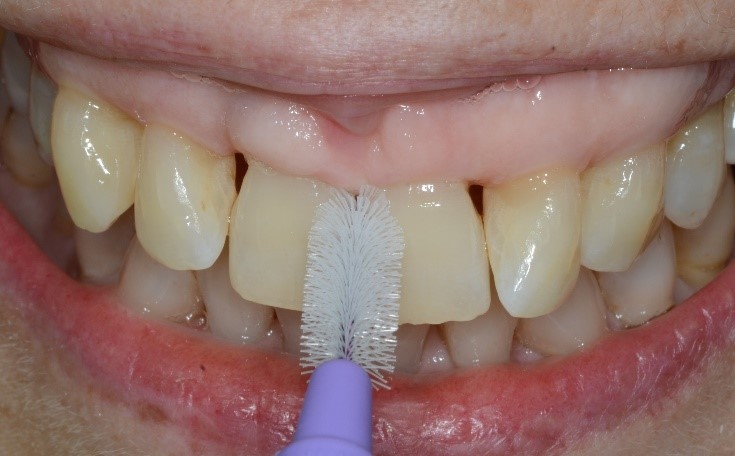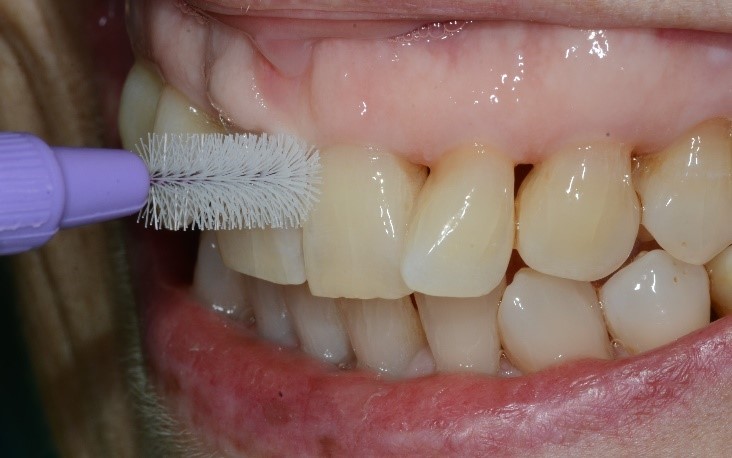Did you know that...? - December 13, 2021
The saying of the Three Musketeers was "One for all, all for one." It would be extremely convenient to think that there is one “universal” oral hygiene tool appropriate for all types of patients/dental conditions and that it is also able to carry out the disintegration of the bacterial biofilm from all dental surfaces. As we all know, the mechanical control of bacterial plaque at least once a day, is the most appropriate strategy for the prevention of gingivitis and carious lesions In addition, the toothbrush alone is not able to reach all spaces, which is why it is important to use tools that go to clean the interdental spaces (Sälzer et al., 2015).
In this article, we discuss interdental brushes and try to understand whether or not they are indicated and effective for cleansing interproximal spaces.
"The space between two adjacent teeth is occupied by the interdental papilla, the portion of free gingiva that extends from the cemento-enamel junction to the contact point. Under conditions of marginal inflammation, local conditions are created that allow better maturation of bacterial plaque"

There are many proposals on the market and some of them are very attractive. However, if we talk about the hygiene of interproximal spaces, the most cited aids are, first of all, the dental floss, after which the interdental brushes, the oral irrigation, woodsticks. As a dental hygienist, giving advice on the correct choice of oral hygiene aids and their effective use is an essential part of my work. It is enough to think about periodontal patients, where in the first instance motivation and education are the key to the success of the patient's adherence to the non-surgical treatment plan. Of course, the better the patient is at mechanically controlling the bacterial biofilm, especially in the interdental spaces, the firmer the pyramid of therapeutic success you are trying to build.
 |
 |
Think of a successful case of yours. You have achieved it, not only because of your skill in articulating the therapeutic protocol and its execution, but also because of: 1) having built a strong relationship of trust and professionalism with the patient, 2) for having informed him correctly about his problem and its management, 3) for having put in his hands the tools best suited to his situation.
Therefore, on the one hand, the technical knowledge we have is important and, on the other, the most appropriate and personalized choice of instruments to be recommended.
There are several scientific studies that examine interproximal hygiene aids and try to demonstrate their effectiveness. We start from the assumption that all studies show that the toothbrush used alone has less effectiveness in reducing the plaque index than when used with an interproximal aid.
When comparing flossing and brushing in combination, most studies show a significant difference between the two tools in terms of plaque index, putting the brushes first (Slot et al., 2008). It is imperative to keep in mind that brushes should be recommended in the right size for each space, knowing that in most cases, the interproximal space of the anterior teeth is smaller than that of the premolars and molars (Drisko, 2013; Schmage et al., 1999). Patients, generally, between the dental floss and the interdental brush prefer to use the latter, because it considered easier to use (Ishak & Watts, 2007).
Another interesting fact is what is reported in the meta-review by Sälzer et al. about oral irrigators. Specifically, the authors conclude that irrigators in addition to brushing, in regular home oral hygiene, lead to a positive trend when it comes to gingival health. In a 4-week study, a greater efficacy in reducing gingival bleeding is reported when using the oral irrigator in combination with brushing in a regular home oral hygiene routine, compared to flossing. The exact mechanism of this observation remains unclear. Probably the result is related to the fact that the mechanism of bacterial biofilm adhesion and maturation is disturbed on a daily basis, or because the flow and pulsation of the water jet helps to reduce the levels of inflammatory mediators at the level of the gingival sulcus/pocket, whereby an improvement in gingival health and its homeostasis is achieved (Sälzer et al., 2015). However, there is currently little evidence to support their use for the reduction of interproximal plaque.
In conclusion, most studies agree that:
- Interdental brushes and toothbrushes remove more plaque, compared to brushing alone, or compared to toothbrushing and flossing/woodsticks;
- There is non exhaustive evidence regarding the effect of interdental brushes on gingival inflammation;
- There are no differences regarding gingival inflammation between the use of interdental brushes and dental floss;
- Underlying everything should be the principle of customization so that the patient can use the interproximal instrument on a daily basis (Drisko, 2013; Cheapple et al., 2015; Slot et al., 2008; Sälzer et al., 2015; Poklepovic Pericic et al., 2013).
Literature and suggested reads
1. Drisko C. L. (2013). Periodontal self-care: evidence-based support. Periodontology 2000, 62(1), 243–255. https://doi.org/10.1111/prd.12012
2. Slot, D. E., Dörfer, C. E., & Van der Weijden, G. A. (2008). The efficacy of interdental brushes on plaque and parameters of periodontal inflammation: a systematic review. International Journal of Dental Hygiene, 6(4), 253–264. https://doi.org/10.1111/j.1601-5037.2008.00330.x
3. Noorlin, I., & Watts, T. L. (2007). A comparison of the efficacy and ease of use of dental floss and interproximal brushes in a randomised split mouth trial incorporating an assessment of subgingival plaque. Oral Health & Preventive Dentistry, 5(1), 13–18. https://pubmed.ncbi.nlm.nih.gov/17366756/
4. Chapple, I. L., Van der Weijden, F., Doerfer, C., Herrera, D., Shapira, L., Polak, D., Madianos, P., Louropoulou, A., Machtei, E., Donos, N., Greenwell, H., Van Winkelhoff, A. J., Eren Kuru, B., Arweiler, N., Teughels, W., Aimetti, M., Molina, A., Montero, E., & Graziani, F. (2015). Primary prevention of periodontitis: managing gingivitis. Journal of Clinical Periodontology, 42 Suppl 16, S71–S76. https://doi.org/10.1111/jcpe.12366
5. Sälzer, S., Slot, D. E., Van der Weijden, F. A., & Dörfer, C. E. (2015). Efficacy of inter-dental mechanical plaque control in managing gingivitis--a meta-review. Journal of Clinical Periodontology, 42 Suppl 16, S92–S105. https://doi.org/10.1111/jcpe.12363
6. Worthington, H. V., MacDonald, L., Poklepovic Pericic, T., Sambunjak, D., Johnson, T. M., Imai, P., & Clarkson, J. E. (2019). Home use of interdental cleaning devices, in addition to toothbrushing, for preventing and controlling periodontal diseases and dental caries. The Cochrane Database of Systematic Reviews, 4(4), CD012018. https://doi.org/10.1002/14651858.CD012018.pub2
7. Graziani, F., Palazzolo, A., Gennai, S., Karapetsa, D., Giuca, M. R., Cei, S., Filice, N., Petrini, M., & Nisi, M. (2018). Interdental plaque reduction after use of different devices in young subjects with intact papilla: A randomized clinical trial. International Journal of Dental Hygiene, 16(3), 389–396. https://doi.org/10.1111/idh.12318
8. Poklepovic, T., Worthington, H. V., Johnson, T. M., Sambunjak, D., Imai, P., Clarkson, J. E., & Tugwell, P. (2013). Interdental brushing for the prevention and control of periodontal diseases and dental caries in adults. The Cochrane Database of Systematic Reviews, (12), CD009857. https://doi.org/10.1002/14651858.CD009857.pub2
